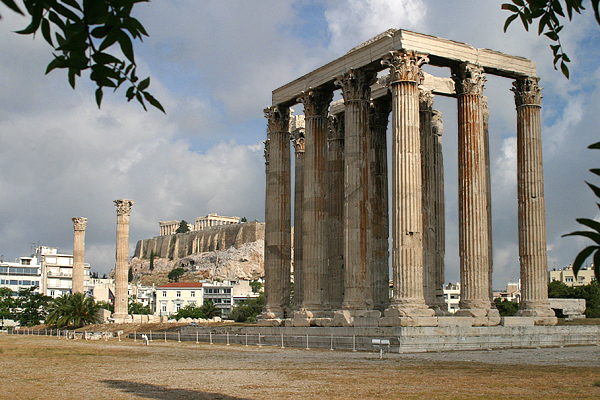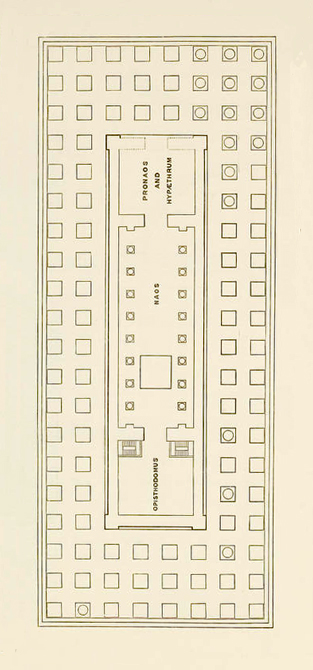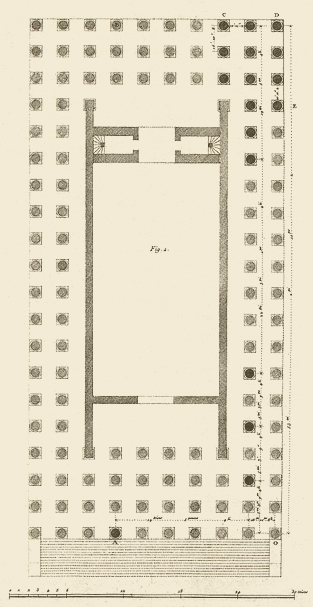
"This work is not only universally esteemed, but is accounted one of the rarest specimens of magnificence."
Vitruvius, On Architecture (VII.Pref.15)
Dedicated to Olympian Zeus, the Olympieion was situated on the bank of the river Ilissus southeast of the Acropolis. It was built on the site of an ancient Doric temple, the foundation of which had been laid out by the tyrant Pisistratus, but construction was abandoned several decades later in 510 BC when his son Hippias, whose rule had become increasingly despotic, was expelled from Athens and a democracy established (he would return twenty years later with the Persians at Marathon, Thucydides, Peloponnesian War, VI.54ff). Aristotle cites the temple and the pyramids of Egypt as examples of how rulers subdue their populations by engaging them in such grandiose projects. Kept poor and preoccupied with hard work, there was not the time to conspire (Politics, V.11). Over three centuries later, in 174 BC, Antiochus IV Epiphanes (king of Syria and the "vile person" of Daniel 11:21) commissioned the Roman architect Cossutius to begin work again on the same ground plan. He did so "with great skill and taste," says Vitruvius, constructing a temple "of large dimensions, and of the Corinthian order and proportions" (On Architecture, VII, Pref.15, 17). Of all the works of Antiochus, the Temple of Jupiter Olympius or Olympian (as the Romans called it) was the "only one in the world, the plan of which was suitable to the greatness of the deity" (Livy, History of Rome, XLI.20). But when the king died a decade later, the temple still was "left half finished" (Strabo, Geography, IX.1.17), although it extended at least to the architrave of the columns still standing at the southeastern corner.
This hiatus would last for another three hundred years. Plutarch compares the temple to Plato's dialogue Critias, which also remained incomplete. "Therefore the greater our delight in what he actually wrote, the greater is our distress in view of what he left undone. For as the Olympieion in the city of Athens, so the tale of the lost Atlantis in the wisdom of Plato is the only one among many beautiful works to remain unfinished" (Life of Solon, XXXII.2). Even after the temple had been dedicated a generation earlier, the Greek satirist Lucian has an impatient Zeus asking whether the Athenians ever intend finishing it (Icaromenippus, XXIV). Then, in 86 BC, Sulla sacked the city in his war against Mithridates and removed some of the monolithic columns from the cella to reconstruct the Temple of Jupiter Capitolinus in Rome, which had burned to the ground three years earlier during civil war (Plutarch, Life of Sulla, XXVII.6; this introduction may have influenced the development of the Corinthian order there).
Augustus once had planned to collect funds for the completion of the temple, which he intended to dedicate to himself (Suetonius, Life of Augustus, LX), but nothing seems to have come of the scheme. The Olympieion would be finished by Hadrian, who had ordered work to begin during his first visit to Athens in AD 124-125 and dedicated the temple in AD 131-132 during his last visit, more than six centuries after construction first had begun. Inside was a statue of the emperor, as well as a snake brought from India (Dio, Roman History, LXIX.16.1). This offering was in homage to Erichthonius, who was identified with the sacred serpent that dwelled in the Erechtheium on the Acropolis and thought to be the serpent coiled next to Athena in the Parthenon. There also was a chryselephantine statue of Zeus, modeled on the original by Pheidias at Olympia which was, according to Pausanias, "one worth seeing, which in size exceeds all other statues save the colossi at Rhodes and Rome, and is made of ivory and gold with an artistic skill which is remarkable when the size is taken into account" (Description of Greece, I.18.6). In addition to the temple and its cult statue, Hadrian also constructed a paved court around the temple and its precinct wall, which was entered through the propylon.
The temple quarter, itself, was reconstituted as a new deme, Hadrianopolis, the nearby gate of Hadrian proclaiming "This is Hadrian's not Theseus' city." Within the sacred precinct (temenos) that enclosed the temple, the delegates of a newly restored Hellas were to convene as a Panhellenion (Dio, LXIX.16.2). Hadrian accepted the title of Olympius and received divine honors. Pausanias goes on to say that there were statues of Hadrian at the entrance of the temple; indeed, the precinct was "full of statues; for every city has dedicated a likeness of the emperor Hadrian, and the Athenians have surpassed them in dedicating, behind the temple, the remarkable colossus." He also was honored by a portrait statue in the Parthenon (I.24.7) and an altar to himself (Historia Augusta, XIII.6).
Then, in AD 267, Athens was sacked by the Heruli, a Germanic tribe from the Black Sea region (Zosimus, New History, I.39) and the temple burned, as was the Painted Agora, the ruins being used to build a new inner circuit of protective walls.
Vitruvius characterized the Olympian Jupiter as octastyle (III.2.8) and dipteral (VII.Pref.15), that is, as having eight columns across the principal façade and two rows of columns on each side of the inner cella (or naos in Greek) that held the cult statue. He also described it as hypaethral, a temple that was partly open to the sky with ten columns across the front (decastyle). Whether the Olympieion truly was hypaethral is uncertain, as it had not yet been completed when Vitruvius wrote. The convention was that the proper number of lateral columns should be double the number across the porticoes, plus one. An octastyle temple, therefore, should have seventeen columns on a side; a decastyle temple, twenty-one. This rule would cause eighteenth-century investigators some consternation as they tried to reconcile it with the monuments they actually surveyed. The correct identification of the Temple of Olympian Zeus (the Olympieion), which was called by the Romans the Temple of Jupiter Olympius (Olympian) and known in the eighteenth century as the Columns of Hadrian, can serve as an example.

Penrose (Fig. 12), rotated to match Le Roy
Le Roy (Vol. II, Pl. XXIII) detail Although the Olympieion was the largest temple in Greece, it was surpassed by others even more grand, including the Temple of Artemis (Ephesus), the Temple of Hera (Samos), the Temple of Olympian Zeus (Agrigento), and the Temple of Apollo (Didyma). |
First, it is important to understand the rivalry between the English architects James Stuart and Nicholas Revett, who had visited Athens in 1751-1753, and the French architect Julien-David Le Roy, who, hearing of their proposal to survey the antiquities of the city, traveled there himself early in 1755, just as the two men were returning home. Having stayed in Greece three months, Le Roy announced a book proposal just a year later. The publication of Les Ruines des Plus Beaux Monuments de la Grèce in 1758 galvanized Stuart, who had spent far too much time in the preparation of his own volume. Indeed, Revett was sufficiently irritated at the delay that he sold his interest in the project to Stuart, who then set about revising his text, determined to expose his rival's every error. Even then, four more years were to pass before the Antiquities of Athens finally was published, in 1762. It was so critical that Le Roy was compelled to published a second edition in 1770, in which he completely rearranged the material and put forth his counter-arguments. Much of the dispute between the men relates to the identity of two major ruins: what Le Roy called the "ruins in the bazaar" in the Roman Agora and the Columns of Hadrian to the south of the Acropolis. As Stuart said, the ruin has "so striking an effect, that most Travellers have mistaken it for the Temple of Jupiter Olympia, which in Splendor and Majesty, surpassed every other Structure in Athens." Le Roy had made just that mistake in the first edition of Ruines and was roundly abused for it by Stuart, who thought that the ruins were of the Stoa Poikile, the Painted Stoa where Zeno had taught his philosophy of Stoicism. Rereading Thucydides (Peloponnesian War, II.15.4), Stuart came to realize that "Whatever difficulties attend the disquisition concerning this Building; most evidently it was not the Temple of Jupiter Olympius; for that Temple was situated in the Southern part of the City...whereas this Building stands to the North of the Acropolis." Le Roy was forced to admit his error but he also rejected Stuart's identification. Rather, the ruins in the bazaar almost certainly must be Pausanias' Temple of Juno (Hera). As to Jupiter Olympius, "nothing remains of this celebrated temple." Measuring the Columns of Hadrian, Le Roy drew a plan in which there are three rows of ten columns across the front and rear, and two rows of twenty along the sides. Reading of what he supposed to be its hundred pillars of marble, he was convinced that "So magnificent a temple, in which Hadrian took great pride, undoubtedly embellished Hadrianopolis and must have been its most beautiful ornament." It stood to reason, therefore, that the Columns were the Pantheon of Hadrian, the "sanctuary common to all the gods" mentioned by Pausanias. It certainly could not be the Temple of Jupiter Olympius, as Vitruvius had described it as having eight columns across the front. But "he does not specify the number on the flanks, and so I have made them seventeen, in accordance with the proportions observed by the Greeks." Twenty columns would have caused the temple to have "suffered from an absurd disproportion between width and length." If anything, Stuart relied even more on the descriptive statements of his authorities than in formulating his own. Vitruvius had described the Temple of Jupiter Olympius as octastyle dipteral but also as hypaethral, with ten columns across the porticoes. And a decastyle temple properly should have twenty-one columns along the sides, even though his survey indicated that there were only twenty. So determined was Stuart to conform theory to practice that, in the second volume of Antiquities of Athens, he added an extra row of columns across the principal façade (Plate XXXI). "There will therefore have been one and twenty Columns on the Flank of this magnificent Temple; and of consequence it will have been a Decastyle, or have had ten Columns both in the Portico, and in the Porticus; which is the number that Vitruvius has assigned to the complete Hypaethros" (Vol. II, p.14). So capricious was this interpolation that it was removed by the editor of the third volume, which was published posthumously in 1794 (Vol. III, Chap.II, Plate II). Only when the English architect and astronomer Francis Cranmer Penrose began excavating the site 1883 was he able to determine conclusively the form of the temple and verify its identity. Stuart had been correct in his conjecture that the Columns of Hadrian were those of the Temple of Jupiter Olympius, as Vitruvius had said. The temple was, in fact, octastyle dipteral, with eight columns across the principal façade. But, instead of two rows of seventeen columns, there were twenty—an extraordinary exception to the rule. Citing the Temple of Jupiter Olympius, Le Roy had recognized that there were many examples in Greece "to prove that the architects of that people did not slavishly observe the rules." But, like Stuart, he did not accept that an octastyle temple could have more columns on a side than Vitruvius allowed. As to Le Roy's "ruins in the bazaar" (Vol. II, Pt. I) and the Stoa depicted in Stuart's Antiquities (Vol. I, Chap. V), they actually are the Library of Hadrian (AD 132), once beautiful in its own right. What must have confounded Le Roy, too, was the fact that the ruins in the Agora were in the lower area of the city, cf. Pausanias "As you descend from here to the lower part of the city" (I.18.4), whereas Vitruvius insisted that "The temples of the gods, protectors of the city, also those of Jupiter, Juno, and Minerva, should be on some eminence which commands a view of the greater part of the city" (I.7.1). |
Originally there were 104 Corinthian columns, arranged in two rows of twenty each on the long sides and triple rows of eight on the shorter ends. Twenty-one columns still were standing in the fifteenth century. When Stuart left Athens, there were seventeen, thirteen in one group surmounted by their architrave and four at the other end of the temple. In 1759 one of these outlying columns was pulled down by the civil governor and converted into lime for the construction of a new mosque (Tzistarakis Mosque on Monastiraki Square). In A Classical and Topographical Tour Through Greece (1819), Dodwell relates that four charges of gunpowder had to be set before the column fell. Tzistarakis was fined 8500 piastres "for having destroyed those venerable remains," dismissed and later poisoned. Another column was blown over in a storm in 1852, its scattered drums still to be seen stacked on the ground. Now only fifteen columns of the original peristyle remain standing.
"I shall conclude my remarks on the building of which this beautiful ruin formed a part by observing...how difficult it is to get to the truth in inquiries of this kind; and how readily authors who differ in their opinions persuade themselves that they have found it. Mr. Stuart says...that it is not easy to conceive how anyone ever could have imagined that these were not the remains of the Temple of Jupiter Olympius; and I can truthfully affirm that, for my own part, I have no less difficulty in imaging how Mr. Stuart ever came to suppose that they were."
Julien-David Le Roy, The Ruins of the Most Beautiful Monuments of Greece (p.422)
The architrave of the Temple of Olympian Zeus soared sixty feet above the ground, and Stuart was not able to reach it; consequently, only a ground plan is presented in Volume II of the Antiquities and three more plates in Volume III: a corrected ground plan, the base of one of the columns, and a scenic view. Le Roy, who could find "no ladders in Athens tall enough for the purpose," has only a single scenic view. Penrose was more ingenious and used a rope ladder that was tied to a line with a stone attached and thrown over the architrave. He then hoisted himself up.
The Byzantine chronicler John Zonaras relates an anecdote about the sack of Athens (recited as well by Symeon Magister and Cedrenus, and, in the words of Gibbon, "justly to be suspected as the fanciful conceit of a recent sophist," I.10.3).
"When they had collected all the books in the city, they were planning to burn them. But one of those who among them seem to be wise dissuaded his tribesmen from their undertaking, saying, 'Since they devote their leisure to these, the Greeks are unconcerned with military matters and, thus, become very easily controllable'" (XII.26).
Penrose's book was published by Society of Dilettanti, which also had admitted Stuart and Revett, who brought some measure of professional antiquarian scholarship to a group characterized by Horace Walpole as "a club, for which the nominal qualification is having been in Italy, and the real one, being drunk." It was the president of the club who vehemently disagreed with Elgin's insistence that the Parthenon marbles were by Pheidias.
References: Julien-David Le Roy: The Ruins of the Most Beautiful Monuments of Greece [Les Ruines des Plus Beaux Monuments de la Grèce] (1770/2004) translated by David Britt; The Antiquities of Athens: Measured and Delineated by James Stuart and Nicholas Revett, Painters and Architects (1762-1816/2007) introduction by Frank Salmon; "Athenian Twilight: A.D. 267-600" (1959) by Homer A. Thompson, The Journal of Roman Studies, 49, 61-72; Hadrian: The Restless Emperor (1997) by Anthony R. Birley; An Investigation of the Principles of Athenian Architecture (1888) by Francis Cranmer Penrose (Chap. XII); The History of Zonara: From Alexander Severus to the Death of Theodosius the Great (2009) translated by Thomas M. Banchich and Eugene N. Lane; "Late Antiquity: A.D. 267-700" (1988) by Alison Frantz, Homer A. Thompson, and John Travlos, The Athenian Agora XXIV; Pictorial Dictionary of Ancient Athens (1971) by John Travlos; "The Olympieion at Athens" (1964) by R. E. Wycherley, Greek, Roman, and Bzyantine Studies, 5(3), 161-179.
See also Library of Hadrian.
